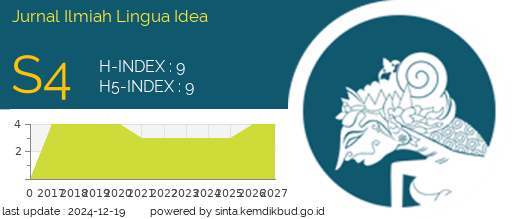Development of Sparkol Videoscribe Interactive Video Learning Media Integrated with Case Method on Pancasila Material
Abstract
This study aims to develop an interactive Sparkol VideoScribe learning video integrated with the case method in the Pancasilacourse, which will enable students to understand the Pancasila material better. The problem is the lack of interactive learning mediathat students can access, especially when learning Pancasila. This research uses the type of research development (Research andDevelopment) with the 4-D development model with the stages of defining, designing, developing and dissemination. Thedevelopment stages are integrated in the activities of 1) Integration of Pancasila material, namely the History of Pancasila Formulation, Pancasila as an Ethical System and Pancasila as the Basis for Science and Technology Development; 2) Integrating the material that has been developed into the Sparkol VideoScribe application; 3) Development of Sparkol VideoScribe Interactive Video integrated with Case Method; 4) Preparation of validation instruments and validation of Sparkol VideoScribe Interactive Video Integrated with Case Method by material experts and media experts; 5) Implementing videos that have beendeveloped to students while reflecting and evaluating; 6) Disseminating research products to students. The results of this studyare based on the results of material expert validation obtained a result of 85% with the category "Very Valid". In addition, basedon the assessment of media experts, the result is 75% with the category "Valid". Based on the assessment results from material andmedia expert validators, the interactive video learning media Sparkol VideoScribe is suitable for use in the Pancasila learning process.
References
Asfar, A., Asfar, A., Aspikal, A., & Nurwijaya, S. (2019). Effectiveness of Case Based Learning (CBL) Accompanied by Feedback on Students' Concept Understanding. Histogram: Journal of Mathematics Education, 3(5), 29-45. https://doi.org/10.31100/histogram.v3i1.293
Dewi, R. K. (2018). Development of Interactive Video on Thematic Science Learning Integrative Human Blood Circulation Material. Scientific Journal of Elementary School, 2(4), 371- 381.
Escalada, L. T., & Zollman, D. A. (1997). An Investigation on the Effects of Using Interactive Digital Video in a Physics Classroom on Student Learning and Attitudes. Journal of Research in Science Teaching, 34(5), 467-489. https://doi.org/10.1002/(SICI)1098- 2736(199705)34:53.0.CO;2-O.
Dewi, R. K. (2018). Development of Interactive Video on Thematic Science Learning Integrative Human Blood Circulation Material. Scientific Journal of Elementary School, 2(4), 371–381.
Gill, G. (2012). ISM4300 and the Case Method. Journal of Information Technology Education: Discussion Cases, 1(1), 1–21. https://doi.org/https://doi.org/10.28945/1701
Hamidi, F., Kharamideh, Z. M., & Ghorbandordinejad, F. (2011). Comparison of the training effects of interactive multimedia (CDs) and non-interactive media (films) on increasing learning speed, accuracy and memorisation in biological science course. Procedia Computer Science, 3, 144- 148. https://doi.org/10.1016/j.procs.2010.12.025.
Huang, C. (2003). Changing Learning with New Interactive and Media-Rich Instruction Environments: Virtual Labs Case Study Report. Computerised Medical Imaging And Graphics, 27, 157-164.
Lightner, S., Bober, M. J., & Willi, C. (2010). Team-Based Activities to Promote Engaged Learning. 55(1), 5-18. https://doi.org/10.3200/CTCH.55.1.5-18
Noor, A. F., & Wangid, M. N. (2019). Energetic Interaction of Teachers and Students in 21st Century Learning. Anterior Journal, 18(2), 107-112. https://doi.org/10.33084/anterior.v18i2.456.
Purnawirawan, O. (2019). Development of 4C (Creativity, Critical Thinking, Communication, and Collaboration) Assessment Instruments for the Twenty-First Century Learning System in Teaching the Productive Field of Vocational High Schools Thesis. Judge.
Risnawati, Amir, Z., & Sari, N. (2018). The Development of Learning Media Based on Visual, Auditory, and Kinesthetic (VAK) Approach to Facilitate Students' Mathematical Understanding Ability. Journal of Physics: Conference Series, 1028(012129), 1-9.
Seidel, R., & Godfrey, E. (2005). Project and Team-based Learning: An Integrated Approach to Engineering Education. 4th ASEE/AaeE Global Colloquium on Engineering Education.
Shidiq, A. S., & Yamtinah, S. (2019). Pre-Service Chemistry Teachers' Attitudes and Attributes Towards The Twenty-First Century Skills. Journal of Physics: Conference Series, 1157(042014), 1-8. https://doi.org/10.1088/1742-6596/1157/4/042014.
Syarafina, D. N., Dewi, E. R., & Amiyani, R. (2017). Application of Case Based Learning (CBL) as an Innovative Mathematics Learning. Seminar on Mathematics and Mathematics Education UNY, 243-250
Thomas, M. D., O'Connor, F. W., Albert, M. L., Boutain, D., & Brandt, P. A. (2001). Case- based teaching and learning experiences. Issues in Mental Health Nursing, 22(5), 517- 531. https://doi.org/10.1080/0161284015239370
Triyono, M. B. (2017). Challenges of the 4th Industrial Revolution for Vocational Education.
Semnasvotek, 4, 1-5.
Water, Jon & et al. (2014). Video Scribing How Whiteboard Animation Will Get You Heart.Bristol, UK: Sparkol Books
Wospakrik, F., Sundari, S., & Musharyanti, L. (2020). The Effect of Applying Case-Based Learning Methods on Student Motivation and Learning Outcomes. JHeS (Journal of Health Studies), 4(1), 30-37. https://doi.org/10.31101/jhes.515

This work is licensed under a Creative Commons Attribution-ShareAlike 4.0 International License.
Authors who publish with Jurnal Ilmiah Lingua Idea agree to the following terms:
- Authors retain copyright and grant the journal right of first publication with the work simultaneously licensed under a Creative Commons Attribution License (CC BY-SA 4.0) that allows others to share the work with an acknowledgment of the work's authorship and initial publication in this journal.
- Authors are able to enter into separate, additional contractual arrangements for the non-exclusive distribution of the journal's published version of the work (e.g., post it to an institutional repository or publish it in a book), with an acknowledgment of its initial publication in this journal.
- Authors are permitted and encouraged to post their work online (e.g., in institutional repositories or on their website) prior to and during the submission process, as it can lead to productive exchanges, as well as earlier and greater citation of published work.





















.png)




_.png)


